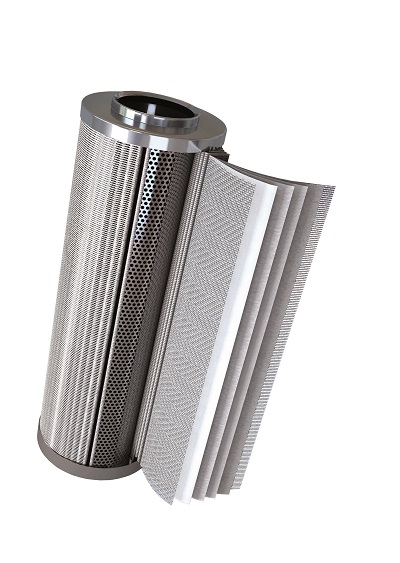Manufacturers make cellulose fibers from long chains of plant material processed into a pulp and then drawn out into strands. Glass media comes from a more complicated process of first drawing molten silica fibers and then combining them into a strand using a resin binder. The product of either process looks surprisingly similar, but their performance resembles each other very little.

Both cellulose and glass media has a place in filtering hydraulic fluid from damaging particles. However, their effectiveness may best be compared to how both an electric scooter and luxury sedan both serve their purpose – the context is essential.
Cellulose filter media offers a thick layer of fiber cloth, pleated and then wrapped around a perforated core. Cellulose may sometimes go by “paper” fiber, which correctly implies a sheet-like fiber pattern across the cloth. Defined as surface media, particles get trapped closer to the paper media’s leading-edge, where particles accumulate and create a resistance to flow.
Some cellulose media also inherently absorb water. This property may be a benefit or disadvantage, depending on your filter’s purpose. Some hydraulic systems are exposed to water contamination, and a cellulose element is excellent at absorbing free water (just not dissolved water). Please note that as water content increases, so does pressure drop as the fibers swell in size.
As far as raw filtering ability goes, the cellulose media merely passes the exam with a minimum grade. Even the best cellulose filter elements are likely less than 75% efficient, which describes a filter that may or may not filter passing particles of a given size. Such a low efficiency gives the media a “nominal” rating, meaning the media’s given micron rating should be taken with a grain of salt.
So if cellulose medium’s benefit list is shorter than its downside list, why use it? It is inexpensive to manufacture, which makes it the scooter in the previous vehicle analogy. A replacement spin-on filter element may often cost little more than your venti blonde americano. With that in mind, you must also consider what a cellulose element is protecting. A log splitter employs commodity-level hydraulic pumps, valves, and cylinders, where economy takes priority over quality. A paper filter media protects essential hydraulic components just fine, and every 20-year-old log splitter is proof of this.
The filter manufacturer uses glass media yarn to create rolls of cloth — the foundation for synthetic glass filter elements. The consistent nature of the fiber layers combined with multiple layers provides glass media superior dirt holding capacity. This “depth media” traps particles through their entire thickness and not just on the surface.
Glass media offers exceptional filter quality, capable in some cases of filtering 3-micron particles with 99.95% efficiency. This effectiveness qualifies the glass media as an “absolute” filtration rating, where lab tests confirm their rating. Immune from water absorption, any free water within your hydraulic oil will not increase pressure drop. However, if you require such absorption, you’ll have to install supplemental cellulose filter assemblies.
Indeed, the glass media filter offers superior dirt holding capacity, finer and more efficient filtration and immunity from water. In many ways, it is superior to cellulose paper filters, so what’s the downside? Cost is easily the downside. A high-quality filter comes at the relative price of a luxury sedan, and such quality filtration is a must to protect expensive hydraulic machinery. Which should you choose? The best you can afford.
Filed Under: Filtration/Contamination Control, Sealing & Contamination Control Tips